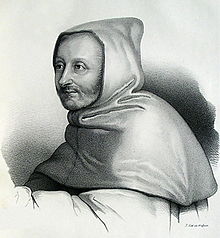Armand Jean le Bouthillier de Rancé
This article needs additional citations for verification. (September 2016) |


Armand Jean le Bouthillier de Rancé (January 9, 1626 Paris – October 27, 1700 Soligny-la-Trappe), abbot and founder of the Trappist Cistercians.
He was originally intended for the Knights of Malta. The illness of his older brother caused his father to dedicate him to ecclesiastical service, in order to preserve in the family the former numerous benefices. At twelve he published a translation of Anacreon with Greek notes. On the death of his brother, in 1637, he became canon of Notre Dame de Paris, abbot of La Trappe Abbey, and of several other places, which gave him a revenue of about 15,000 livres. In 1651, he was ordained priest by his uncle Victor Bouthillier, the Archbishop of Tours, and embarked on a career as a court abbot.
In 1652 his father died, leaving him a further increase in estate. At the age of twenty-six he was thus left with practically unlimited wealth.
His uncle, who desired him as coadjutor, made him archdeacon, caused him to be elected deputy of the second order to the General Assembly of the French Clergy in 1655, and had him appointed first chaplain to Gaston, Duke of Orléans, in 1656.
The death of the Duchess of Montbazon, in 1657, gave him the first serious thought leading to his conversion. And in 1660 he assisted at the death of the Duke of Orléans, which made so great an impression on him that he said: "Either the Gospel deceives us, or this is the house of a reprobate". After having taken counsel, he disposed of all his possessions, except the Abbey of La Trappe, which he visited for the first time in 1662.
He retired to his abbey, of which he became regular abbot in 1664 and introduced an austere reform. Rancé's reform focused first and foremost centered on penitence. It prescribed hard manual labour, silence, a meagre diet, isolation from the world, and renunciation of most studies. The hard labour was in part a penitential exercise, in part a way of keeping the monastery self-supportive so that communication with the world might be kept at a minimum. This was also the reason why Rancé had Louis XIV's permission to remove the highway that ran outside the monastic walls.[1] Rancé devoted the little spare time he had to writing spiritual works. Amongst the most important are: Vies de plusieurs solitaires de La Trappe; Le traité de la sainteté et des devoirs de la vie monastique; La règle de s. Benoît, traduite et expliqué selon son véritable esprit, etc.
His penitential mode of life made him many enemies, and caused him to be accused of Jansenism, but he refrained from defending himself, until finally, at the request of his most intimate friends, he wrote to the Maréchal de Bellefonds, stating that he had signed the Formula (against Jansenism) without restriction or reservation of any kind; adding that he had always submitted himself absolutely to those whom God had placed over him, i.e., the pope and his bishop.
He resigned his abbacy in 1695, owing to declining health, and died in 1700.
A biography of his life, Vie de Rancé, was the final work of the Romantic writer and politician, François-René de Chateaubriand, published in 1844.
References
- ^ Mette B. Bruun, "A Case in which a Revitalization of Something Medieval Turned out not to be Medievalism," in: Falling into Medievalism, ed. Anne Lair and Richard Utz. Special Issue of UNIversitas: The University of Northern Iowa Journal of Research, Scholarship, and Creative Activity, 2.1 (2006).
- This article incorporates text from a publication now in the public domain: Chisholm, Hugh, ed. (1911). Encyclopædia Britannica (11th ed.). Cambridge University Press.
{{cite encyclopedia}}: Missing or empty|title=(help)  This article incorporates text from a publication now in the public domain: Herbermann, Charles, ed. (1913). Catholic Encyclopedia. New York: Robert Appleton Company.
This article incorporates text from a publication now in the public domain: Herbermann, Charles, ed. (1913). Catholic Encyclopedia. New York: Robert Appleton Company. {{cite encyclopedia}}: Missing or empty|title=(help)
